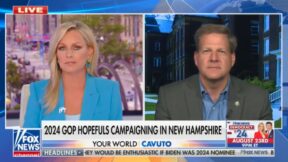Gorsuch Tears Into Sotomayor’s Dissent In Religious Freedom Case: ‘Reimagines The Facts’ And ‘Opens Fire On Its Own Position’

Supreme Court Justice Neil Gorsuch tore into Justice Sonia Sotomayor’s critical dissent in his majority opinion in 303 Creative vs Elenis, a religious freedom case argued before the court this past term.
In his opinion, Gorsuch held that “the First Amendment prohibits Colorado from forcing a website designer to create expressive designs speaking messages with which the designer disagrees,” in this case, gay marriage.
Dissenting for herself as well as Justices Elena Kagan and Ketanji Brown Jackson, Sotomayor called the decision “profoundly wrong,” and argued that its “immediate, symbolic effect,” will be “to mark gays and lesbians for second-class status.”
Gorsuch wasn’t impressed.
“It is difficult to read the dissent and conclude we are looking at the same case,” he begins before arguing that “it reimagines the facts of this case from top to bottom.”
“The dissent claims that Colorado wishes to regulate Ms. Smith’s ‘conduct, not her
speech. Forget Colorado’s stipulation that Ms. Smith’s activities are ‘expressive,’ and the Tenth Circuit’s conclusion that the State seeks to compel ‘pure speech,'” noted Gorsuch before observing that her claim that the decision “grants a business” a “right to refuse to serve members of a protected class.”
“We do no such thing and Colorado itself has stipulated Ms. Smith will (as CADA requires) ‘work with all people regardless of . . . sexual orientation,'” explained Gorsuch. “It is the dissent that would have this Court do something truly novel by allowing a government to coerce an individual to speak contrary to her beliefs on a significant issue of personal conviction, all in order to eliminate ideas that differ from its own.”
Later, Gorsuch found that “in some places, the dissent gets so turned around about the facts that it opens fire on its own position.”
“While stressing that a Colorado company cannot refuse ‘the full and equal enjoyment of [its] services’ based on a customer’s protected status, the dissent assures us that a company selling creative services ‘to the public’ does have a right ‘to decide what messages to include or not to include.’ But if that is true, what are we even debating?” he asks.
He also challenged Sotomayor’s grasp of the relevant case law, submitting that “the dissent’s treatment of precedent parallels its handling of the facts.”
As an example, he offered “its remarkable suggestion that a government forcing an individual to create speech on weighty issues with which she disagrees—all, as the Tenth Circuit found, with the goal of ‘[e]liminating’ views it does not share, only ‘incidental[ly]’ burdens First Amendment liberties.”
“Far from embracing a notion like that, our cases have rejected it time after time—including in the context of public accommodations laws,” he argued.
The combative dialogue between Gorsuch and Sotomayor in 303 Creative followed a similarly heated conversation between Justices Clarence Thomas and Jackson in Students for Fair Admissions v. President and Fellows of Harvard College.
Have a tip we should know? tips@mediaite.com




